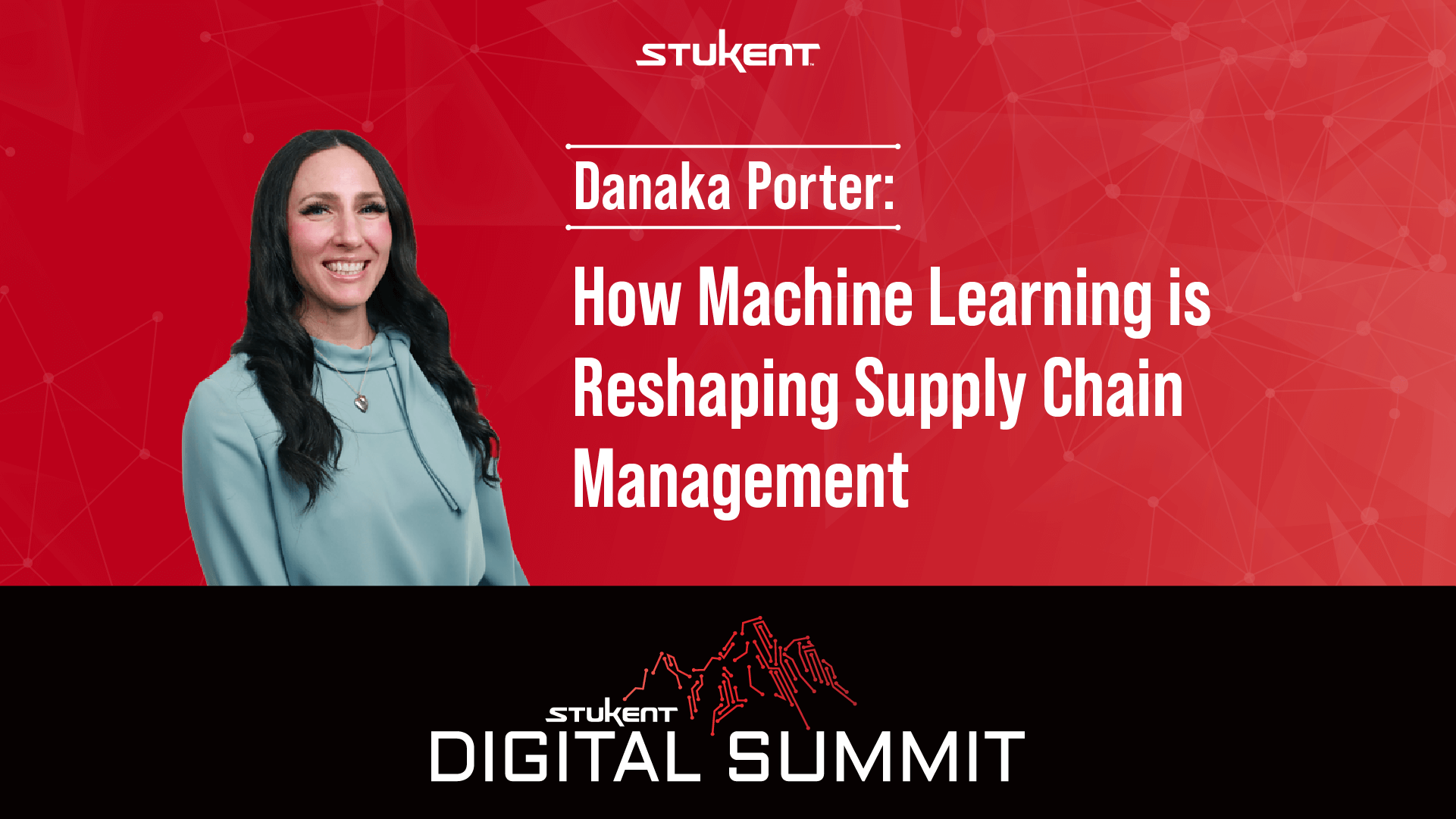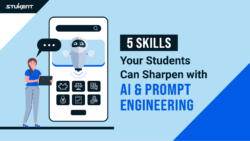Artificial intelligence is more prominent than ever. As this technology expands, professionals from all fields are incorporating time-saving strategies into their workflows.
While the supply chain industry has been using machine learning (ML) for years, supply chain educators now need to prepare their students for the benefits and pitfalls of AI.
Danaka Porter, a regional managing partner at iota consulting, discussed how AI and ML affect supply chains and how to use this new technology in her Stukent® webinar, “Exploring New Opportunities and Challenges: The Impact of AI on Supply Chain Management.” Read on for a recap of her insights!
Understanding AI and ML
How can businesses use AI and ML effectively?
First, it’s important to understand their capabilities. AI helps computers do tasks using data and instructions instead of human input. ML, a part of AI, uses algorithms to learn from experiences and data, which is helpful for tasks like managing supply chains where data changes over time.
ML can find patterns in data that humans might miss. This helps businesses make better decisions based on data, saving costs and improving efficiency. ML works well with a connected warehouse and operations as it constantly updates and reviews free of human interference and without waiting for data to be uploaded. These algorithms continuously evolve as more and more data runs through them.
While AI and ML have potential, Danaka pointed out challenges. The saying “garbage in, garbage out” applies — if the data used is bad, the results will be bad too.
“It’s not entirely predictive,” Danaka said. “Machine learning and any AI use prior data, find these relationships, and make predictions. It’s only as good as the data provided. Supply chains are incredibly complex. That’s why we haven’t seen a massive AI or ML structure for supply chain because there are so many moving parts.”
She stressed the need for accurate, standardized data, especially in supply chain management, where minor errors can cause big problems. Picking the right ML algorithms is also crucial because using the wrong ones can lead to inaccurate results.
Why Use AI and ML?
AI and ML can quickly find patterns in data, helping supply chain professionals with tasks such as managing inventory and predicting demand.
These technologies can also help with making decisions about new products or strategies. ML can find related patterns by looking at each piece of data and its attributes — price, lead time, order frequency, etc. It can group parts by similarities in attributes, which allows for better planning and procurement strategies. For instance, it can identify parts that may be ordered together to decrease costs.
ML is now widely used in the supply chain industry, specifically in production, warehousing, and supply and demand planning. It can predict how a specific market will respond to a new product.
Danaka used real examples to show how AI and machine learning can help supply chains. In one case, she used these technologies to evaluate maintenance needs in the oil and gas sector. She could predict equipment failures and prevent environmental problems using AI and ML. This helped the company save money and avoid costly accidents.
Watch this clip for more details:
Applying AI and ML
Machine learning is helpful to supply chain specialists who focus on inventory management or clustering. Clustering involves analyzing attributes of items, such as cost, shelf life, and demand patterns. The clusters can be used for critical spare parts by optimizing their replenishment plans based on attributes. Danaka showcased how this approach identified patterns even in complex scenarios, such as equipment operating in different conditions than intended. Clusters helped identify part relationships and create efficient replenishment strategies.
Danaka shared a real-world application where the Canadian Department of National Defense employed clustering to tackle excess inventory issues. She reduced part classifications from 16 to six using K-means clustering to streamline replenishment plans. This resulted in a 34% decrease in excess inventory, saving millions while maintaining part availability.
Danaka also emphasized the significance of proper data preparation, algorithm selection, and parameter setting to achieve accurate results. By focusing on specific questions, cleaning data, choosing appropriate algorithms, and providing sufficient data, machine learning can enhance supply chain efficiency and cost-effectiveness, ultimately delivering substantial benefits.
Danaka’s Steps for Success
While understanding ML and how it works is helpful, setting students up for success when using these programs is also essential. Danaka provided five tips for using machine learning in supply chain management:
1. Select a specific question for the model to answer: Start by clearly defining the specific question or problem you want to address. Whether it’s about predicting equipment failure, optimizing inventory, or enhancing demand forecasting, you need a well-defined goal.
2. Ensure that every piece of data is properly labeled and entered: Data quality is crucial for accurate AI outcomes. Ensure your data is clean, complete, and properly labeled. Eliminate duplicates, correct inaccuracies, and deal with missing values. This step is crucial because AI models rely heavily on data input.
3. Select the appropriate algorithm for the data and the desired result: Different AI algorithms suit different problems. It’s important to choose the right algorithm for your specific use case. For example, clustering algorithms like K-means can be suitable for inventory optimization, while regression algorithms might be used for demand forecasting.
4. Choose key parameters that best measure the desired outcome (health or failure): Define the parameters and limitations of your AI model. Set thresholds for actions such as reorder points, lead times, or maintenance intervals. These parameters help guide decision-making and ensure AI-generated insights align with practical considerations.
5. Allow the ML algorithm to review as much previous data as possible: AI algorithms thrive on data volume and diversity. The more data you can provide, the better your AI model can learn patterns and trends. Ensure you have enough historical data to train and effectively test your algorithms.
Empowering Supply Chain Students With ML
“It’s important to show students the difference between having good data and bad data,” Danaka said. “Show them that we can use this fancy technology all they want, but if you put in crappy data, that’s what you’re going to get out of it.” AI can’t do everything for supply chain professionals, so demonstrate for students how much work they must put in beforehand to get successful results from an AI platform.
While AI and ML hold immense promise, their effectiveness relies on maintaining accurate, standardized data and executing a strategic implementation approach. Real-world instances validate their impact, ranging from curbing inventory costs to predicting maintenance needs. Sharing Danaka’s five steps can better prepare your students for using machine learning, or you can empower them with Stukent’s Principles of Supply Chain Bundle.
The bundle comes with the Supply Chain Simternship™, which places students in real-world supply chain roles, and Danaka’s “Principles of Supply Chain Management and Operations” courseware, a comprehensive text blended with hundreds of instructor resources.
Stukent Digital Summit: Supply Chain was held online on August 18, 2023. If you want to see Stukent’s upcoming events, visit the Events page on our website.
Stukent is here to help educators help students help the world. To learn more about our first-in-the-world Simternships and courseware, or to get FREE instructor access to our products, visit our website.






